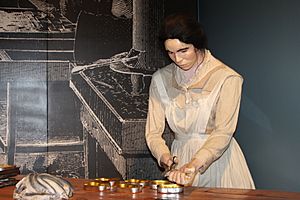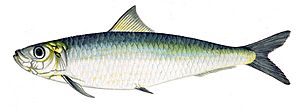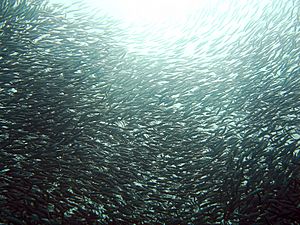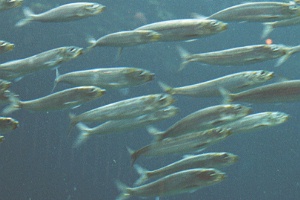Sardine facts for kids
(reported by the FAO 1950–2009)
A sardine is the name for several types of small, oily fish. They are also called pilchards. These fish are usually small and are related to the herring. Their scientific family name is Clupeidae.
The name "sardine" comes from the Island of Sardinia. In the past, it was very easy to catch these fish there.
Many shops and supermarkets sell canned sardines. Sometimes, these cans might actually contain other similar fish, like sprats or round herrings.
Contents
What Sardines Eat
Sardines mostly eat tiny ocean creatures called zooplankton. They gather in places where there is a lot of this food.
How Sardines Are Fished
Sardines are usually caught using large nets that surround them. These nets are called purse seines. Fishermen also use other methods, like traps or fishing weirs. These are like fences in the water that guide the fish into an enclosed area.
Sardines are mostly caught at night. This is when they swim closer to the surface to eat plankton. After being caught, the fish are put into salty water. This keeps them fresh while they are taken to shore.
Sardines are caught for many reasons. They are used as bait for other fish. People also eat them fresh, dried, salted, or smoked. Sometimes, sardines are turned into fish meal for animal feed or oil for things like paint. However, most sardines are caught for people to eat.
Sardines as Food

Sardines are a popular food for people. Fresh sardines are often grilled, pickled, or smoked. They are also commonly sold in cans.
Sardines are packed with vitamins and minerals. Eating a small serving of sardines every day can give you many important nutrients. For example, they provide a lot of vitamin B12. All B vitamins help your nervous system work well. They also help your body turn food into energy.
Sardines are also rich in important minerals. These include phosphorus, calcium, and potassium. They also have trace minerals like iron and selenium.
These fish are a natural source of healthy omega-3 fatty acids. These fats can help keep your heart healthy. Eating omega-3s regularly might also lower the chance of getting Alzheimer's disease. They can also help control blood sugar levels. Sardines are also a good source of vitamin D and protein.
Because sardines are low in the food chain, they have very low levels of harmful substances like mercury. This is good compared to some other fish that people eat.
History of Sardine Fishing
Sardine Fishing in the UK
Pilchard fishing was a big business in Cornwall, UK, from about 1750 to 1880. After that, it started to decline. The number of fish caught changed each year. For example, in 1871, 47,000 hogsheads of pilchards were caught. A hogshead was a large barrel that held 2,300 to 4,000 pilchards.
Most of the pilchards were sent to Roman Catholic countries like Italy and Spain. There, they were known as fermades. The oil from the fish was mostly sold in Bristol. It was used for machinery.
Since 1997, sardines from Cornwall have been sold as "Cornish sardines." In 2010, they received special protection under EU law. This means only sardines from Cornwall can use that name. The fishing industry has been shown in many artworks, especially by artists from the Newlyn School.
There is a traditional "Toast to Pilchards" that talks about how valuable these fish were for exporting to Catholic Europe:
- Here's health to the Pope, may he live to repent
- And add just six months to the term of his Lent
- And tell all his vassals from Rome to the Poles,
- There's nothing like pilchards for saving their souls!
Sardine Fishing in the United States
In the United States, the sardine canning industry was at its peak in the 1950s. After that, it started to shrink. The canneries in Monterey Bay, California, which were known as Cannery Row, closed in the mid-1950s. The last big sardine cannery in the U.S. closed in 2010 after 135 years.
In 2015, the Pacific Fishery Management Council decided to stop commercial sardine fishing. This was for Oregon, Washington, and California. They did this because the number of Pacific sardines had dropped a lot. This ban affected about 100 fishing boats. The ban was expected to last for more than a year and was still in place in 2019.
Sardines in Popular Culture

The way sardines are packed tightly in a can led to the saying "packed like sardines." This phrase means that people or things are crowded very closely together. The poet Spike Milligan joked about this in his poem "Sardine Submarine." In the poem, a sardine's mother describes a submarine as "a tin full of people."
"Sardines" is also the name of a children's game. In this game, one person hides. Then, everyone who finds the hidden person squeezes into the same hiding spot. This continues until only one person is left out. That person becomes the next one to hide.
In the Mediterranean city of Marseille, people like to exaggerate. This is linked to a folk tale about a sardine. The story says a sardine supposedly blocked the city's port in the 1700s. However, it was actually a ship called the "Sartine" that blocked the port.
Images for kids
-
In the 1980s, the South American pilchard, Sardinops sagax, was the most caught type of sardine. Some major fish groups dropped a lot in the 1990s.
-
The Pacific sardine, Sardinops sagax caerulea.
See also
 In Spanish: Sardina para niños
In Spanish: Sardina para niños






